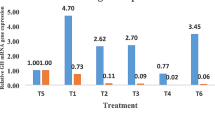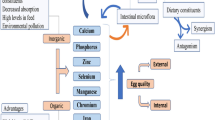Abstract
The present study was carried out to investigate the effect of dietary supplementation of organic selenium (Se) on performance, egg quality indices, and yolk oxidative stability in laying hens fed diets with different fat sources. A total of 270 Hy-line W-36 Leghorn hens of 47 weeks of age were randomly distributed into the 5 replicate cages of 9 dietary treatments. Experimental diets consisted of a 3 × 3 factorial arrangement of treatments with three different fat sources (soybean oil, SO; yellow grease, YG; and palm fat powder, PFP) and three different levels of supplemental Se (0, 0.2, and 0.4 mg/kg of diet) as supplied by zinc-L-selenomethionine (ZnSeMet) complex, which fed during a 77-day feeding trial including 7 days for adaptation and 70 days as the main recording period. Results showed that the highest (P < 0.05) egg weights assigned to the hens fed on SO-supplemented diets. Hen-day egg production was affected by both dietary fat source (P < 0.01) and Se level (P < 0.05) throughout the trial period. Regardless of dietary fat source, dietary supplementation of ZnSeMet improved (P < 0.05) egg mass during all trial periods. Moreover, the significant (P < 0.05) fat source× Se interactions were observed for egg mass, so that dietary supplementation with 0.4 mg/kg Se was more effective in diets supplemented with YG. Although feed intake was not affected by experimental diets during the first 35-day period, dietary inclusion of PFP reduced feed intake during both second 35-day (P < 0.01) and entire trial period (P < 0.05). The best (P < 0.01) feed conversion ratio during the first 35-day period was assigned to the birds fed on SO-diets, followed by those fed YG-diets. Dietary supplementation of ZnSeMet improved (P < 0.05) feed efficiency during the first 35-day period. Supplementation of ZnSeMet into the diets increased yolk index, with more impact in hens fed on YG-diets. The highest concentration of yolk malondialdehyde was observed in YG-fed groups, and ZnSeMet supplementation of diets decreased (P < 0.05) yolk malondialdehyde. The highest (P<0.01) glutathione peroxidase activity was observed for hens fed on diets supplemented by YG, followed by those on SO-diets. Although different fat sources had no effect on antibody titer against Newcastle disease virus, supplemental ZnSeMet improved (P < 0.05) antibody response. The present findings indicate that dietary supplementation of ZnSeMet could improve performance parameters and egg oxidative stability in laying hens, with the highest impact in diets containing oxidized (high peroxide values) fat sources.
Similar content being viewed by others
References
Baiao NC, Lara LJC (2005) Oil and fat in broiler nutrition. Braz J Poult Sci 7:129–141
National Research Council (1994) Nutrient requirements of poultry, 9th edn. Natl. Acad. Press, Washington, DC
Korver DR, Roura E, Klasing KC (1998) Effect of dietary energy level and oil source on broiler performance and response to an inflammatory challenge. Poult Sci 77:1217–1227
Isika MA, Agiang EA, Okon BI (2001) Determination of the metabolizable energy of broiler offal fat. J Appl Sci Educ 4:16–22
Brake J (1990) Effect of four levels of added fat on broiler breeder performance. Poult Sci 69:1659–1663
Pardio VT, Landin LA, Waliszewski KN, Pérez-Gil F, Diaz L, Hernandez B (2005) The effect of soybean soapstock on the quality parameters and fatty acid composition of the hen egg yolk. Poult Sci 84:148–157
Simopoulos AP, Robinson J (1998) The Omega Plan. Harper Collins Publishers, New York
Bou R, Grimpa S, Guardiola F, Barroeta AC, Codony R (2006) Effects of various fat sources, α-tocopheryl acetate, and ascorbic acid supplements on fatty acid composition and α-tocopherol content in raw and vacuum-packed, cooked dark chicken meat. Poult Sci 85:1472–1481
Klein EA (2004) Selenium: epidemiology and basic science. J Urol 171:S50–S53
Nazıroğlu M (2009) Role of selenium on calcium signaling and oxidative stress-induced molecular pathways in epilepsy. Neurochem Res 34:2181–2191
Senol N, Nazıroğlu M, Yürüker V (2014) N-acetylcysteine and selenium modulate oxidative stress, antioxidant vitamin and cytokine values in traumatic brain injury-induced rats. Neurochem Res 39:685–692
Pappas AC, Acamovic T, Sparks NHC, Surai PF, McDevitt RM (2005) Effects of supplementing broiler breeder diets with organic selenium and polyunsaturated fatty acids on egg quality during storage. Poult Sci 84:865–874
Paton ND, Cantor AH, Pescatore AJ, Ford MJ, Smith CA (2002) The effect of dietary selenium source and level on the uptake of selenium by developing chick embryos. Poult Sci 81:1548–1554
Kim YJ, Park WY, Choi IH (2010) Effects of dietary α-tocopherol, selenium, and their different combinations on growth performance and meat quality of broiler chickens. Poult Sci 89:603–608
Cantor AH, Moorhead PD, Musser MA (1982) Comparative effects of sodium selenite and selenomethionine upon nutritional muscular dystrophy, selenium-dependent glutathione peroxidase, and tissue selenium concentrations of turkey poults. Poult Sci 61:478–484
Payne RL, Lavergne TK, Southern LL (2005) Effect of inorganic versus organic selenium on hen production and selenium concentration. Poult Sci 84:232–237
Hy-Line International (2007) Hy-Line W-36 commercial management guide. Hy-Line International, West Des Moines
López-Ferrer S, Baucells MD, Barroeta AC, Grashorn MA (1999) n-3 enrichment of chicken meat using fish oil: alternative substitution with rapeseed and linseed oils. Poult Sci 78:356–365
Association of Official Analytical Chemists (2002) Official Methods of Analysis of AOAC International. 17th ed., Washington, DC., USA
Jahanian R, Rasouli E (2014) Effects of dietary supplementation of palm fatty acid powders on performance, internal egg quality and yolk oxidation stability in laying hens during early egg production. Ind J Anim Sci 84:191–197
Silversides FG (1994) Is the Haugh unit for egg weight valid for eggs stored at room temperature? Poult Sci 73:50–55
Cherian G, Wolfe FH, Sim JS (1996) Dietary oils with added tocopherols: effects on egg or tissue tocopherols, fatty acids, and oxidative stability. Poult Sci 75:423–431
Leeson S, Namkung H, Caston L, Durosoy S, Schlegel P (2008) Comparison of selenium levels and sources and dietary fat quality in diets for broiler breeders and layer hens. Poult Sci 87:2605–2612
Jahanian R (2009) Immunological responses as affected by dietary protein and arginine concentrations in starting broiler chicks. Poult Sci 88:1818–1824
van der Zijpp AJ, Leenstra FR (1980) Genetic analysis of the humoral immune response of white leghorn chicks. Poult Sci 59:1363–1369
SAS Institute (1999) SAS statistics user’s guide. Statistical analytical system, 5th edn. SAS Institute Inc, Carry
Duncan DB (1955) Multiple range and multiple F tests. Biometrics 11:1–42
March BE, MacMillan C (1990) Linoleic acid as a modulator of egg size. Poult Sci 69:634–639
Vila B, Esteve-Garcia E (1996) Studies on acid oils and fatty acids for chickens. II. Effects of free fatty acid content and degree of saturation of free fatty acids and neutral fat on fatty acid digestibility. Br Poult Sci 37:119–130
Cantor AH, Straw ML, Ford MJ, Pescatore AJ, Dunlap MK (2000) Effect of feeding organic selenium in diets of laying hens on egg selenium content. In: Sim JS, Nakai S, Guenter W (eds) Egg nutrition and biotechnology. CABI Publishing, New York, p 473
Cantor AH, Scott ML (1974) The effect of selenium in the hen’s diet on egg production, hatchability, performance of progeny and selenium concentration in eggs. Poult Sci 53:1870–1880
Siske V, Zeman L, Klecker D (2000) In: Lyons TP, Jacques KA (eds) The egg shell: a case study in improving quality by altering mineral metabolism-naturally. Proc. Alltech’s 16th Ann Symp Biotechnol Feed Indust, Nottingham University Press, Nottingham, p 37
Marshal AC, Sams AR, Van Elswyk ME (1994) Oxidative stability and sensory quality of stored eggs from hens fed 1.5% menhaden oil. J Food Sci 59:561–563
Kang KR, Cherian G, Sim JS (2001) Dietary palm oil alters the lipid stability of polyunsaturated fatty acid-modified poultry products. Poult Sci 80:228–234
Wang ZG, Pan XJ, Peng ZQ, Zhao RQ, Zhou GH (2009) Methionine and selenium yeast supplementation of the maternal diets affects color, water-holding capacity, and oxidative stability of their male offspring meat at the early stage. Poult Sci 88:1096–1101
Ryu Y-C, Rhee M-S, Lee K-M, Kim B-C (2005) Effects of different levels of dietary supplemental selenium on performance, lipid oxidation, and color stability of broiler chicks. Poult Sci 84:809–815
Ort JF, Latshaw JD (1978) The toxic level of sodium selenite in the diet of laying hens. J Nutr 108:1114–1120
Devore VR, Colnago GL, Jensen LS, Greene BE (1983) Thiobarbituric acid values and glutathione peroxidase activity in muscle from chickens fed a selenium- supplemented diet. J Food Sci 48:300–301
Payne RL, Southern LL (2005) Comparison of inorganic and organic selenium sources for broilers. Poult Sci 84:898–902
Mckenzie RC, Arthur JR, Miller SM, Rafferty TS, Beckett GJ (2002) Selenium and the immune system. In: Calder PC, Field CJ, Gill NS (eds) Nutrition and immune function. CAB International, Oxford, pp 229–250
Acknowledgments
Special thanks are extended to Dr. Ajilchi (chairman of Sana Dam Pars Co., Tehran, Iran) and Zinpro Corporation (Edina, MN, USA) for providing us with zinc-L-selenomethionine complex.
Conflict of Interest
The authors declare no conflict of interest.
Author information
Authors and Affiliations
Corresponding author
Rights and permissions
About this article
Cite this article
Laika, M., Jahanian, R. Dietary Supplementation of Organic Selenium Could Improve Performance, Antibody Response, and Yolk Oxidative Stability in Laying Hens Fed on Diets Containing Oxidized Fat. Biol Trace Elem Res 165, 195–205 (2015). https://doi.org/10.1007/s12011-015-0251-5
Received:
Accepted:
Published:
Issue Date:
DOI: https://doi.org/10.1007/s12011-015-0251-5




